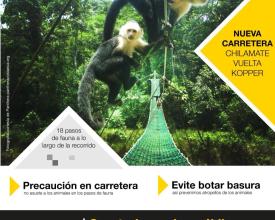
Découverte de preuves de l'impact de la route sur la faune sauvage depuis 70 ans et proposition de mesures d'atténuation. Route 2 : Interamericana Sur-Costa Rica

Il est nécessaire de produire des preuves solides de l'impact des routes sur la faune dans les régions tropicales riches en biodiversité afin de proposer la mise en œuvre de mesures d'atténuation. La Méso-Amérique est une région riche en biodiversité et l'expansion et l'amélioration des routes sont en augmentation. Des tapirs, des oncillas, un lapin endémique et de nombreuses autres espèces ont été tués sur la route 2 : Interamericana Sur au Costa Rica. Les pièges photographiques et les études routières nous donneront des informations sur leur distribution et sur la façon dont ils sont affectés par cette route. Ces informations nous permettront de recommander des mesures d'atténuation (par exemple, des passages souterrains, des clôtures, des passages arboricoles) afin de réduire le risque d'être tué par les voitures et d'assurer la connectivité de leurs populations. La collecte de ce type de données sur une route existante et l'utilisation ultérieure de ces informations pour demander des mesures d'atténuation est une nouvelle étape pour le pays et sera mise en œuvre grâce à un effort de collaboration entre Panthera et plusieurs entités gouvernementales.
Contexte
Défis à relever
La Méso-Amérique est une région riche en biodiversité et l'expansion et l'amélioration des routes sont en cours. Nous manquons de données appropriées sur les régions méso-américaines concernant les implications de l'impact des routes sur la faune et les mesures d'atténuation spécifiques. Nous devons montrer, à l'aide de recherches solides, ce qui est en dessous des mesures d'atténuation appropriées. Les taipirs, les oncillas, le lapin à queue blanche de Dice et de nombreuses autres espèces seront surveillés. Des pièges photographiques et des études routières nous donneront des informations sur leur répartition et leur vulnérabilité face aux routes. Ces informations nous aideront à recommander des mesures pour qu'elles puissent traverser la route en toute sécurité, assurer la connectivité de leurs populations et rendre la route plus sûre pour les conducteurs. La collecte de données sur la faune et la flore sur une route existante et l'utilisation de ces informations pour demander des mesures d'atténuation est une procédure nouvelle pour le pays et sera mise en œuvre par une équipe interdisciplinaire.
Emplacement
Traiter
Résumé du processus
L'un des éléments constitutifs est une orientation générale pour la mise en œuvre de mesures environnementales sur les routes afin de réduire l'impact sur la faune et la flore. L'autre est un effort pour répondre au besoin spécifique de mise en œuvre de mesures d'atténuation pour la vie sauvage sur les routes existantes, à partir de 2020.
Blocs de construction
Mesures d'atténuation sur les routes pour la faune et la sécurité des conducteurs
Dans les régions riches en biodiversité, les routes dépourvues de mesures d'atténuation pour les espèces sauvages entraînent une fragmentation de l'écosystème. Ce problème est encore plus important si la route se trouve entre des zones protégées et si des espèces menacées meurent à la suite de collisions avec des véhicules. Les mesures de protection de la faune sont plus efficaces lorsqu'elles sont mises en œuvre sur la base d'une collecte de données locales sur la faune. La mise en œuvre de mesures d'atténuation telles que les passages pour animaux sauvages peut commencer à restaurer la connectivité de l'écosystème entre les zones protégées en présence d'une route. Ces mesures rendent également la route plus sûre pour les conducteurs, grâce à la réduction des collisions avec la faune.
Facteurs favorables
1. Étude scientifique visant à déterminer l'impact de la route sur la faune et les mesures d'atténuation nécessaires pour réduire cet impact ;
2. Travail d'équipe : Gouvernement (environnement et transport) et chercheurs ;
3. Gestion à long terme ;
4. Législation pour soutenir la mise en œuvre des mesures ;
5. Budget pour la mise en œuvre des mesures ;
Leçon apprise
Un travail de sensibilisation préalable doit être effectué auprès des représentants du gouvernement. Au Costa Rica, nous avons travaillé pendant 10 ans sur la recommandation de mesures d'atténuation sur les routes pour la faune. C'est un long chemin, mais lorsque les mesures d'atténuation sont coûteuses, il faut une gestion à long terme pour obtenir des résultats solides. Les mesures d'atténuation sur les nouveaux projets routiers sont mises en œuvre depuis 2015, mais pour les routes existantes, nous venons juste de trouver le moyen de les mettre en œuvre, grâce à un travail de collaboration, en 2020. Ce projet est l'une de nos premières tentatives au niveau national pour activer le processus de mise en œuvre des mesures sur les routes existantes, par le biais des activités d'entretien.
Guide de l'environnement : Routes respectueuses de la faune
Ce guide est l'outil utilisé pour collecter des données sur la faune et la flore sur les routes afin d'identifier l'impact et de recommander des mesures pour le Costa Rica. Il peut être utilisé pour les nouveaux projets routiers et pour les routes existantes. Depuis 2015, ce guide est utilisé par le gouvernement du Costa Rica pour mettre en œuvre des mesures sur les nouveaux projets routiers. Nous avons commencé à le mettre en œuvre sur les routes existantes à partir de 2020.
Facteurs favorables
1. Participation des pouvoirs publics ;
2. Financement de la collecte de données ;
3. Législation demandant des mesures pour réduire l'impact du développement sur la faune ;
4. Inclusion dans l'étude d'impact sur l'environnement ;
5. Financement de la mise en œuvre de mesures visant à prévenir ou à réduire l'impact des routes ;
Leçon apprise
Dans de nombreux pays de la région méso-américaine, des conseils sont nécessaires pour réduire l'impact des routes. Ce document peut donc être adapté aux caractéristiques locales et à la législation du pays pour commencer à mettre en œuvre des mesures sur les routes en faveur de la faune ;
Impacts
En 2019, en collaboration avec des représentants du ministère des transports, du ministère de l'environnement et d'ONG, nous avons trouvé une procédure que le gouvernement pourrait utiliser pour mettre en œuvre des mesures en faveur de la faune sur les routes existantes. Nous devons produire des informations scientifiques solides pour formuler les recommandations appropriées sur la route 2, où de nombreux animaux sauvages ont été tués sur la route, dont 30 tapirs au cours des 10 dernières années. Nous travaillons en collaboration avec les représentants des parcs nationaux et des réserves forestières situés en bordure de route, ainsi qu'avec le bureau local du ministère des transports publics, afin d'activer la procédure sur la route 2. À ce jour, nous avons : - identifié 60 drains de 194 sous la route 2 qui peuvent servir de passages souterrains pour la faune avec des travaux de réaménagement - identifié l'utilisation de ces drains par les lapins, les belettes, les ratons laveurs et les écureuils - estimation de 4.000 animaux sauvages morts sur la route 2 en raison de collisions avec des véhicules en un an - identification de pécaris, tapirs, pumas et oncillas dans les zones protégées environnantes - cette année, deux tapirs et un oncille sont morts à la suite de collisions avec des véhicules - constitution d'un groupe de travail avec des représentants du gouvernement afin de consolider la procédure de mise en œuvre de mesures sur cette route existante, la route 2. En décembre, un rapport final sera remis au ministère de l'environnement pour validation. Ils procéderont à la demande de mise en œuvre des mesures auprès du ministère des Transports.
Bénéficiaires
Ecosystèmes des zones protégées, communautés locales, administrations et gardes forestiers entourant la Route 2 ;
Conducteurs de la route 2 ;
Autres routes existantes où les mesures d'atténuation pour la faune et la flore font défaut dans la région méso-américaine ;
Objectifs de développement durable
Histoire

Des routes sûres pour tous
J'ai été l'un des premiers écologistes des transports et j'ai travaillé avec de nombreux autres écologistes au fur et à mesure que ce domaine de la science appliquée se développait. L'écologie des transports est un domaine clé pour atténuer les effets du développement linéaire sur la connectivité des habitats et les déplacements de la faune. Je connais Daniela Araya-Gamboa depuis environ 8 ans, et je l'ai observée et encadrée, ainsi que ses collègues féminines, alors qu'elle faisait preuve d'un leadership admirable et innovant au Costa Rica. Son dernier projet sur la Route 2 : l'autoroute interaméricaine est l'un de ses meilleurs efforts, car elle a reconnu et saisi l'occasion d'utiliser une situation extrêmement rare, voire unique, non seulement pour atténuer les effets sur cette autoroute, mais aussi pour approfondir les connaissances sur la façon d'atténuer les effets sur d'autres autoroutes. Alors qu'elle trouve des informations essentielles sur la manière d'atténuer les effets uniques sur les espèces d'Amérique centrale, ses conclusions seront utilisées à l'échelle mondiale pour faire progresser un jeune domaine scientifique. J'ai examiné avec elle la méthodologie de ce projet et j'ai été impressionné par son approche et par l'importance de ses premiers résultats, ainsi que par les possibilités passionnantes qu'offre la suite du projet. Elle a également su exploiter de manière créative ses ressources limitées grâce à un soutien en nature et à son propre temps limité pour obtenir des résultats utiles dans un laps de temps très court. Je recommande vivement de soutenir ce projet et la direction de Mme Araya-Gamboa. ---Sandra L. Jacobson, biologiste de la faune sauvage à la retraite, US Forest Service, Pacific Southwest Research Station, Davis, CA.















